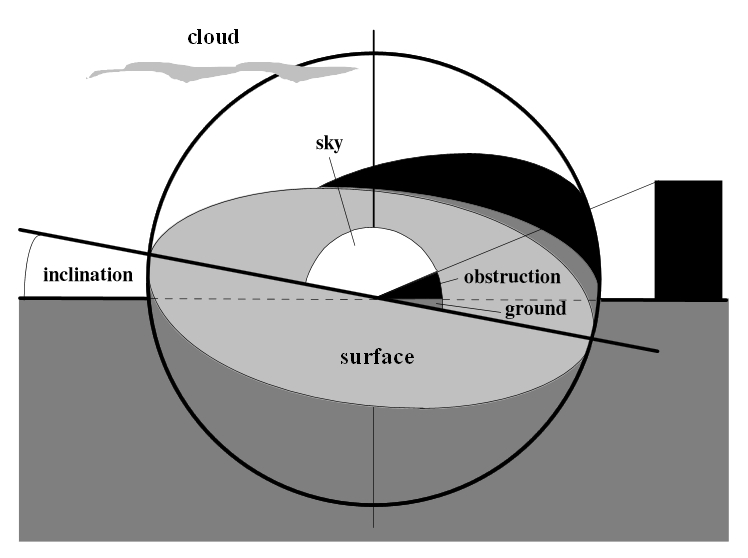Sky temperature
Radiation is a heat transfer mechanism, along with conduction, convection and phase change. All bodies which are hotter than 0°K emit thermal radiation. They also absorb thermal radiation emitted by their surroundings. The difference in the total amount of radiation emitted and absorbed by a body at any given moment may result in a net heat transfer which will produce a change in the temperature of that body.
Thermal radiation includes all those wavelengths of the electromagnetic spectrum which will heat a body when absorbed by it, ranging from about 100nm to 100,000nm. In general, the higher the temperature of a body, the lower the average wavelength of the radiation it emits. The range of terrestrial temperatures experienced within the built environment is relatively small, and relative to the temperature of the sun this range is ‘cold’ and so radiating at a ‘long’ wavelength compared to the sun. This anomaly allows us to categorise thermal radiation as short-wave solar radiation and terrestrial or long wave infra-red radiation.
Terrestrial surfaces exchange long wave infra-red radiation in all directions within a hemisphere about their azimuth. This hemisphere can include a wide variety of thermal bodies, ranging from the sky to the ground and solid bodies, such as buildings, all of which will be emitting different intensities and wavelengths of thermal radiation themselves. In order to simplify this complex situation terrestrial radiation is generally treated as an average heat transfer based on hemispherical emissivities and average hemispherical surface temperatures.
The exchange of long wave infra-red radiation between a surface and the sky will depend on the exposure of the body to it, which may be affected by the angle of inclination, the extent to which it is obstructed, for example by other buildings, and the sky temperature.
The temperature in outer space approaches absolute zero at around 3 Kelvin, or -270°C. However, the atmosphere of the earth contains gases such as carbon dioxide, water vapour and other particles, which themselves emit long wave infra-red radiation, increasing the effective sky temperature.
This means that at any given location, the sky temperature will depend on variables such as altitude, humidity, cloud cover and the presence of other particles in the air such dust or pollution.
Under cloudless conditions in the desert, sky temperatures close to -50°C are commonly recorded, whilst in humid, cloudy conditions in countries such as Thailand, sky temperatures might be close to 20°C. Very broadly, the average sky temperature is likely to be near to 0°C.
An infrared thermometer can be used to measure the sky temperature. But care must be taken over the direction it is pointed, and how an average is determined. A different reading will be given depending on whether the temperature is measured at the zenith, where there is less atmosphere between the thermometer and space, or close to the horizon, and whether the temperature of a cloud is recorded or of the clear sky.
The sky temperature can be calculated for a given location if the amount of cloud cover is known. This can be estimated, or during the day, can be calculated by comparing the intensity of monitored horizontal global solar radiation with that amount which would theoretically have been recorded if the sky were perfectly clear.
[edit] Related articles on Designing Buildings
- Albedo.
- Cool roof.
- Dry-bulb temperature.
- Electromagnetic spectrum.
- Emissivity.
- Globe temperature.
- Mean radiant temperature.
- Operative temperature.
- Predicted mean vote.
- Psychometric chart.
- Running mean temperature.
- Sling psychrometer.
- Solar reflectance index.
- Temperature
- The thermal behaviour of spaces enclosed by fabric membranes.
- Thermal comfort.
- Thermal indices.
- Thermal optical properties.
- Thermal pleasure in the built environment.
- Urban heat islands.
- Wet-bulb globe temperature.
- Wet-bulb temperature.
Featured articles and news
RTPI leader to become new CIOB Chief Executive Officer
Dr Victoria Hills MRTPI, FICE to take over after Caroline Gumble’s departure.
Social and affordable housing, a long term plan for delivery
The “Delivering a Decade of Renewal for Social and Affordable Housing” strategy sets out future path.
A change to adoptive architecture
Effects of global weather warming on architectural detailing, material choice and human interaction.
The proposed publicly owned and backed subsidiary of Homes England, to facilitate new homes.
How big is the problem and what can we do to mitigate the effects?
Overheating guidance and tools for building designers
A number of cool guides to help with the heat.
The UK's Modern Industrial Strategy: A 10 year plan
Previous consultation criticism, current key elements and general support with some persisting reservations.
Building Safety Regulator reforms
New roles, new staff and a new fast track service pave the way for a single construction regulator.
Architectural Technologist CPDs and Communications
CIAT CPD… and how you can do it!
Cooling centres and cool spaces
Managing extreme heat in cities by directing the public to places for heat stress relief and water sources.
Winter gardens: A brief history and warm variations
Extending the season with glass in different forms and terms.
Restoring Great Yarmouth's Winter Gardens
Transforming one of the least sustainable constructions imaginable.
Construction Skills Mission Board launch sector drive
Newly formed government and industry collaboration set strategy for recruiting an additional 100,000 construction workers a year.
New Architects Code comes into effect in September 2025
ARB Architects Code of Conduct and Practice available with ongoing consultation regarding guidance.
Welsh Skills Body (Medr) launches ambitious plan
The new skills body brings together funding and regulation of tertiary education and research for the devolved nation.
Paul Gandy FCIOB announced as next CIOB President
Former Tilbury Douglas CEO takes helm.
UK Infrastructure: A 10 Year Strategy. In brief with reactions
With the National Infrastructure and Service Transformation Authority (NISTA).























